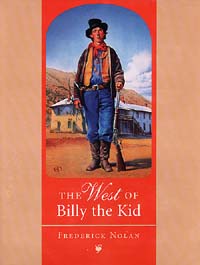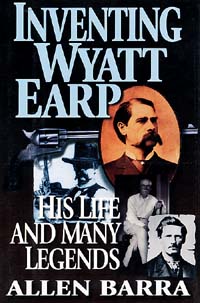Titles That Can't Myth
Fri., May 28, 1999
|
|
Allen Barra, a former Chronicle contributor, takes a close-up look at the facts, fiction, and pop culture status of another American icon in Inventing Wyatt Earp: His Life and Many Legends (Carroll & Graf, $27 hard). In this amusing, eyeopening, entertaining book, Barra marvels at the incredible proliferation of Wyatt Earp's legend in media, culture, and everyday vernacular. Earp has become shorthand for no-nonsense authoritarian behavior. Every other day the media finds a political or military showdown they call a "shoot-out at the OK Corral." The real Wyatt Earp wasn't a one-dimensional, straight-shooting lawman in a white hat but a very complex individual, with certain motivations and habits that today might be considered unsavory. Among other things, he was a gambler, a hustler, and a consort of prostitutes. Certainly, Earp deserves his larger-than-life status, although some of the actions that made him famous need careful scrutiny. The real shootout at the OK Corral, Barra points out, occurred in 1881, lasted a mere 30 seconds, and took place in an alley outside the corral. And it was actually Earp's bloody vendetta against members of the Clanton-McLaury gang, who later ambushed his brother, Virgil, that really cleaned up Tombstone and assured Earp a place in history. Not to mention the fact that killing all his enemies was one of the secrets to his longevity. By the time Earp died in 1929, he'd run through an amazing repertoire of pursuits: buffalo hunter, lawman, goldbricker (a con game involving painted bricks sold as gold bullion to suckers), prospector, prize fight referee. In many ways, Earp embodies the West we still celebrate. He had a dark side, too, but don't we all?
It's been 176 years since the first company of men were authorized to act as "rangers" on the dangerous fringes of Texas settlements, and almost 65 years since the publication of Walter Prescott Webb's The Texas Rangers: A Century of Frontier Defense, long regarded as the comprehensive, standard authority on the subject. Webb's great book is still highly readable but it does seem a bit creaky in places these days. Webb had a superb understanding of the relationship between environment and the human activities that took place there, however, and strains of his themes still resound today in the best Ranger histories. Leander McNelly: Texas Ranger by Bob Scott (Eakin Press, $18.95 paper) tells the story of one of Texas' most famous Rangers in a narrative style that reads like a novel. McNelly was short and thin and unhealthy, but he was a born leader, and with a small band of extremely loyal Rangers, succeeded in the monumental task of bringing law and order to the hotly contested Nueces Strip. When the U.S. Army tried to order McNelly to stop invading Mexico whenever he felt like it, McNelly sent a telegram telling the U.S. Army and the Secretary of War to go to hell.
The Law Comes to Texas: The Texas Rangers 1870-1901 by Frederick Wilkins (State House Press, $29.95 hard; $19.95 paper) details the history of the so-called "special rangers" like McNelly, as well as the legendary Frontier Battalion, which was organized after the Civil War. This is a rip-roaring swath of history, covering the exploits of Sam Bass, McNelly, Rip Ford, John Kingfisher, Lee Hall, Jack Armstrong and George Baylor, to name just a smidgen. Wilkins gives readers an inside view of Ranger incidents and adventures, drawing heavily from correspondence, firsthand accounts, and records. In techno-culture parlance, this one may be for history geeks only, but it's a much-needed contribution nonetheless.
|
|
The awesome sweep of Texas history that the Rangers saga embraces is truly captured in They Rode for the Lone Star: The Saga of the Texas Rangers by Thomas W. Knowles (Taylor Publishing, $29.95 hard). The first of a two-volume series, Knowles' history explores the very roots of the ranger concept, which had antecedents not only in the culture of the Spanish empire in Texas but also with Texans' Celtic ancestors and the "ranging" units who used guerrilla tactics in the French and Indian wars. By prepping his canvas in this manner, Knowles sets out to do what he does best, hitting the high notes and broad strokes of Ranger history, establishing the idea of the Ranger as the original, seminal Texan and a true product of his environment. For the bulk of this lavishly illustrated, powerfully written book, the author portrays the Ranger as a man who was one of us, often not that different than a member of a frontier neighborhood watch program with a license to kill when necessary. And it was necessary a lot of the time. Correcting the idea that Rangers were all white men until recently, Knowles' chronicle of the contributions of Indian and Hispanic Rangers is fascinating and refreshing. This volume ends with the post-Civil War era, during which Republican Governor E.J. Davis temporarily replaced the Rangers with the State Police force, whose ranks included a large number of African-Americans, and were greatly resented and hated by white Texans. Many modern scholars have unfairly and inaccurately lambasted Davis and the State Police, but Knowles is not among them.
The Texas Ranger museum in Waco is the second-biggest tourist attraction between Dallas and the Mexican border, number one being one of the few places in Texas where the "no hats allowed" rule is strictly enforced: the Alamo. A new book, The Alamo: An Illustrated History, by Edwin P. Hoyt (Taylor Publishing, $29.95 hard), may not have unearthed any secret mysteries about that shrine of Texas liberty, but this fast-moving, sensibly attenuated narrative does present the story from a modern, intelligent, all-encompassing perspective that never deviates from its human scale. Hoyt, as usual, does a marvelous job of storytelling without resorting to novelistic inventions. Like flies on the walls of the past, we learn the private motivations and moods and secret agendas of all the various major players leading up to and beyond the Texans' doomed last stand. We also gain a feeling for what a shaky and seemingly ill-considered enterprise the whole thing was from the very beginning: A few lucky victories in 1835, then Sam Houston sent a party of men to the Alamo in early '36, not to defend it, but to blow it up and abandon it because Houston flatly believed there was no hope of being able to defend that run-down, rambling old Spanish mission. As things turned out, somebody had a better idea.
-- Jesse Sublett








